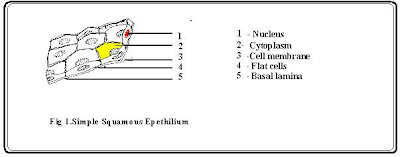Multiple choice questions with Answers
1) True
or False The high ordered structure of the phospholipid bilayer makes its
production and maintenance energetically unfavorable.
Answer - True
2) Which
of the following statements regarding lipid membranes is not True
A) Membrane
lipid diffuse within the plane of the membrane
B)The
preferred form of a lipid bilayer in water is a flat sheet with exposed edges.
C) Membrane
lipids don’t flip-flop between once monolayer and the other.
D) Membrane
proteins can move around.
E) In eucaryotes, some organelles are
surrounded by two lipid bilayers
Answer – B
3) Which
of the following phospholipid bilayers would be more fluid?
A) One
with mostly saturated fatty acids
B) One
with only saturated fatty acids
C) One
with no cholesterol
D) One
with mostly unsaturated fatty acids
E) One
with equal amounts of saturated and unsaturated fatty acids
Answer – B
4) A
bacterium is suddenly expelled from a warm human intestine into the cold world
outside. Which of the following adjustments might the bacterium make to
maintain the same level of membrane fluidity?
A) Produce
lipids with hydrocarbon tails have fewer double bonds.
B) Produce
lipids with hydrocarbon tails that have more double bonds.
C) Decrease
the amount of cholestererol in the membrane.
D) Decrease
the amount of glycolipids in the membrane
E) Add
more protein to the membrane
Answer – A
5) True
of False when a mouse cell is fused with a human cell, the movement of the
respective membrane proteins is restricted to their original locations at the
time of fusion.
Answer –
False
6) Of
the following functions, the glycoproteins and glycolipids of animal cell
membranes are most important for
A) The
ability of cells to recognize each other
B) Maintaining
membrane fluidity at low temperatures.
C) Active
transport of molecules against their concentration gradients.
D) Maintaining
the integrity of a fluid mosaic membrane
E) Facilitated
diffusion of molecules down their concentration gradients.
Answer – A
7) Which
of the following would not be a good reason why a cellular membrane needs to
contain protein?
A) Membranes
do not form without some proteins.
B) Proteins
are needed to transport some molecules across the membrane
C) Proteins
may be needed to help attach the cell to extracellular structures
D) Proteins
may be needed to anchor the membrane to the cyctoskeleton
E) All
of these are good reasons why cellular membranes need proteins.
Answer – A
8) An alpha
helical protein domain can cross the membrane provided that there is a stretch of
10 or 11 amino acids with hydrophobic side chains
TRUE
9) CO2 or O2 are water-soluble molecules that
diffuse freely across cell membranes
Answer- TRUE
10) Molecules
that move against their concentration gradient via………………….require a protein transporter to cross the
membrane
A) Diffusion
B) Facilitated
diffusion
C) Active
transport
D) Osmosis
E) Both
B and C are correct
Answer - C
11) Which of the following requires a membrane
protein?
A) Facilitated
diffusion
B) Primary
active transport
C) Secondary
active transport
D) All
of these
E) A
and B only
Answer – D
12) When food
molecules are broken down to provide energy and a molecule from outside the
cell acts as the final electron acceptor in the process it is called
A) Fermentation
B) Glycolysis
C) Oxidative
phosphorylation
D) Substrate-level
phosphorylation
E) Respiration
Answer - E
13)The
ATP generated during glycolysis is always produce by way of
A) Fermentation
B) Glycolysis
C) Oxidative
phosphorylation
D) Substrate-level
phosphorylation
E) Respiration
Answer – D
14)During the
breakdown of sugars carbon dioxide is released during
A) Glycolysis
B) The
citric acid cycle
C) Oxidative
phosphorylation
D) Substrate-level
phosphorylation
E) Beta
oxidation
Answer - B
------------------------------------------End of
Document-----------------------------------------------------







